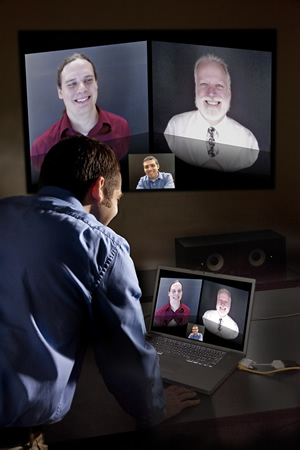Description:

| Jeffrey R. Spies with (onscreen, left to right) Timothy R.
Brick and Steven M. Boker, Ph.D. |
Executive Summary
University of Virginia researchers have
developed a novel method for enhancing users’ video-conferencing experience by
enabling apparent three-dimensionality with the use of a single camera.
High-presence and direct eye-contact conversations are achieved under
low-bandwidth requirements without the need for expensive motion-capture
technologies or multi-camera
arrays.
Background
Video-conferencing has become an
increasingly popular way to engage in personal and business-related
communications, with noted drawbacks stemming from participants’ lack of
physical co-presence and technical demands for high bandwidth.
Typically, due to the physical displacement between a user’s camera and
screen, participants cannot simultaneously watch and make eye contact with other
users on-screen. This physical displacement alters micro-facial expressions that
would normally occur in face-to-face meetings and may make participants feel
uncomfortable, potentially damaging conversations and relationships.
While current technologies exist to enhance co-presence, they often
consist of elaborate motion-tracking systems and multi-camera arrays, which are
expensive and demand high bandwidth requirements, making them undesirable in
many video-conferencing situations.
Invention
Description
Developed by quantitative psychology researchers, the
invention is a method for providing high-presence, real-time video-conferencing
through simulated three-dimensionality. Using a single camera, each
participant’s face and movements are captured, tracked and reduced to a few data
points using statistical modeling. In this way, important facial features are
captured and transmitted over very low bandwidth (a few hundred bytes per
frame).
At the remote device, motion parallax is used to reconstruct a
simulated 3-D image that is modified to reflect the viewing angle and location
of the recipient viewer, creating a near-photorealistic video of each
participant’s face. This feature also allows apparent eye contact to be made and
broken, as it is in in-person conversation.
View a Demo
View a brief demo movie of the technology in action.
Advantages
The invention offers several advantages over
conventional technologies:
- High-presence video-conferencing is achieved through a single camera,
minimizing costs and the need for any special equipment
- Direct eye contact allows for more life-like conversation
- Use of statistical facial modeling allows for high-quality video
transmission over low bandwidths, making it ideally suited for mobile
technology
Potential Applications
The invention can be used to
enhance a wide range of applications for which effective communication is
imperative, such as:
- Video communications: enhancing conversations while reducing bandwidth,
especially attractive for mobile devices
- Online gaming and animation: allowing users to manipulate avatar facial
expressions
- Motion-picture industry: allowing easy post-alterations to an actor’s
facial expressions, better reflecting a dubbed recording
- Medical, marketing and sports industries: increasing the consumer’s sense
of physical presence at an event
